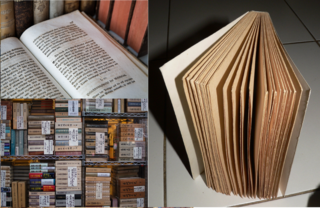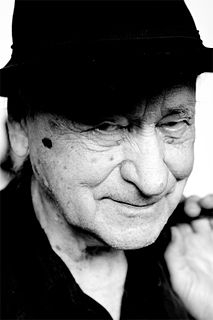
Valerie Jean Solanas was an American radical feminist and author best known for writing the SCUM Manifesto, which she self-published in 1967, and attempting to murder Andy Warhol in 1968.

Batman Dracula is a 1964 black and white American film produced and directed by Andy Warhol, without the permission of DC Comics, publishers of comics about the character Batman.
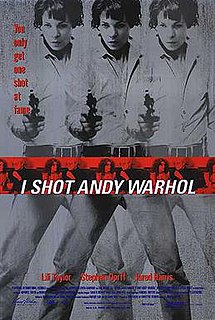
I Shot Andy Warhol is a 1996 American-British independent film about the life of Valerie Solanas and her relationship with the artist Andy Warhol. The film marked the feature film directorial debut of Canadian director Mary Harron. The film stars Lili Taylor as Valerie, Jared Harris as Andy Warhol, and Martha Plimpton as Valerie's friend Stevie. Stephen Dorff plays Warhol superstar Candy Darling. John Cale of The Velvet Underground wrote the film's score despite protests from former band member Lou Reed. Yo La Tengo plays an anonymous band that is somewhat reminiscent of the group.
Warhol superstars were a clique of New York City personalities promoted by the pop artist Andy Warhol during the 1960s and early 1970s. These personalities appeared in Warhol's artworks and accompanied him in his social life, epitomizing his famous dictum, "In the future everyone will be famous for fifteen minutes". Warhol would simply film them, and declare them "superstars".

Gerard Joseph Malanga is an American poet, photographer, filmmaker, curator and archivist.
15 minutes of fame is short-lived media publicity or celebrity of an individual or phenomenon. The expression was inspired by Andy Warhol's words "In the future, everyone will be world-famous for 15 minutes", which appeared in the program for a 1968 exhibition of his work at the Moderna Museet in Stockholm, Sweden. Photographer Nat Finkelstein claimed credit for the expression, stating that he was photographing Warhol in 1966 for a proposed book. A crowd gathered trying to get into the pictures and Warhol supposedly remarked that everyone wants to be famous, to which Finkelstein replied, "Yeah, for about fifteen minutes, Andy." The phenomenon is often used in reference to figures in the entertainment industry or other areas of popular culture, such as reality television and YouTube.
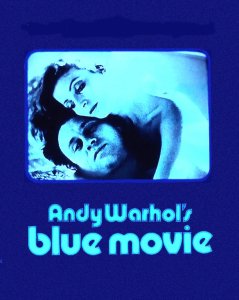
Blue Movie is a 1969 American film written, produced, and directed by Andy Warhol. Blue Movie, the first adult erotic film depicting explicit sex to receive wide theatrical release in the United States, is a seminal film in the Golden Age of Porn (1969–1984) and helped inaugurate the "porno chic" phenomenon in modern American culture, and later, in many other countries throughout the world. According to Warhol, Blue Movie was a major influence in the making of Last Tango in Paris, an internationally controversial erotic drama film, starring Marlon Brando, and released a few years after Blue Movie was made. Viva and Louis Waldon, playing themselves, starred in Blue Movie.

Vinyl is a 1965 American black-and-white experimental film directed by Andy Warhol at The Factory. It is an early adaptation of Anthony Burgess' novel A Clockwork Orange, starring Gerard Malanga, Edie Sedgwick, Ondine, and Tosh Carillo, and featuring such songs as "Nowhere to Run" by Martha and the Vandellas, "Tired of Waiting for You" by The Kinks, "The Last Time" by The Rolling Stones and "Shout" by The Isley Brothers.

Isabelle Collin Dufresne was a French-American artist, author, and both a colleague of Andy Warhol and one of the pop artist's so-called superstars. Earlier in her career, she worked for and studied with surrealist artist Salvador Dalí. Dufresne lived and worked in New York City, and also had a studio in Nice, France.

a, A Novel is a 1968 book by the American artist Andy Warhol published by Grove Press. It is a nearly word-for-word transcription of tapes recorded by Warhol and Ondine over a two-year period in 1965–1967.

The Exploding Plastic Inevitable, sometimes simply called Plastic Inevitable or EPI, was a series of multimedia events organized by Andy Warhol between 1966 and 1967, featuring musical performances by The Velvet Underground and Nico, screenings of Warhol's films, and dancing and performances by regulars of Warhol's Factory, especially Mary Woronov and Gerard Malanga. Andy Warhol's Exploding Plastic Inevitable is also the title of an 18-minute film by Ronald Nameth with recordings from one week of performances of the shows which were filmed in Chicago, Illinois, in 1966. In December 1966 Warhol included a one-off magazine called The Plastic Exploding Inevitable as part of the Aspen No. 3 package.
John Wilcock was a British journalist known for his work in the underground press, as well as his travel guide books.
Susan Bottomly, also known as International Velvet, is a former American model and actress. She is known for her appearances in several of Andy Warhol's underground films.
Since is a 1966 film directed by Andy Warhol about the assassination of the President of the United States, John F. Kennedy. The film reconstructs the assassination with both Kennedy and Lyndon B. Johnson present, both before and after the event. The roles in Since are performed by Warhol's "superstars" from The Factory.
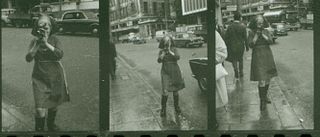
Barbara Rubin was an American filmmaker and performance artist. She is best known for her landmark 1963 underground film, Christmas on Earth.
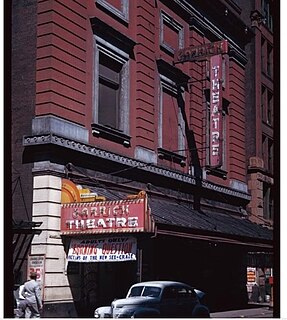
The Garrick Cinema—periodically referred to as the New Andy Warhol Garrick Theatre, Andy Warhol's Garrick Cinema, Garrick Theatre, Nickelodeon—was a 199-seat movie house located in Greenwich Village at 152 Bleecker Street, Lower Manhattan, New York City. Andy Warhol debuted many of his notable films in this building in the late 1960s. The Cafe Au Go Go was located in the basement of the theater building in the late 1960s, and was a prominent Greenwich Village night club, featuring many well known musical groups, folksingers and comedy acts.

The 55th Street Playhouse—periodically referred to as the 55th Street Cinema and Europa Theatre—was a 253-seat movie house at 154 West 55th Street, Midtown Manhattan, New York City, that opened on May 20, 1927. Many classic art and foreign-language films, including those by Jean Cocteau, Sergei Eisenstein, Federico Fellini, Abel Gance, Fritz Lang, and Orson Welles, were featured at the theater. Later, Andy Warhol presented many of his notable films in this building in the late 1960s. Other notable films were also shown at the theater, including Boys in the Sand (1971) and Him (1974).

Untitled from Marilyn Monroe (1967) is one of a portfolio of ten 36 x 36 silkscreened prints by the pop artist Andy Warhol, showcasing 1950's controversial film star Marilyn Monroe after her passing in 1962, creating an intersection of art, glamour and death. The original image was borrowed by Warhol from a promotional still captured by Gene Kornman and released for the film Niagara (1953) featuring Monroe, raising questions on the extent of artistic appropriation. The cropped and ultimately untouched images have since been recognised as iconic and influential on contemporary art, forming the foundations of what is now known as pop art.


